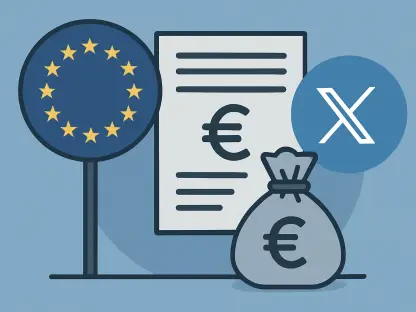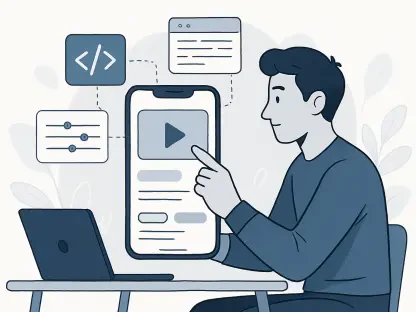Imagine a scenario where filing federal taxes is no longer a dreaded, time-consuming ordeal, but a quick and intuitive task completed in just 15 minutes on a free mobile app, with all necessary data pre-filled and refunds processed almost instantly. This compelling vision isn’t a distant fantasy but a tangible goal driving the urgent push to transform the Internal Revenue Service (IRS) into a digital-first, user-centric agency. Currently, the reality for most Americans stands in stark contrast, with an average of 13 hours and $270 spent out of pocket annually to navigate confusing forms, outdated systems, and frustrating wait times for support. The IRS consistently ranks last among federal agencies in citizen satisfaction, signaling a profound need for change. This article delves into a bold blueprint for modernization, drawing inspiration from the seamless functionality of mobile banking apps. The focus extends beyond simply improving tax filing; it’s about redefining how government services interact with citizens through innovative technology and renewed trust. By exploring lessons from past initiatives like Direct File and insights from experts at the U.S. Digital Service, a roadmap emerges for systemic reform. The ultimate aim is to make tax filing effortless while setting a powerful precedent for all federal agencies to follow suit in enhancing digital service delivery.
Transforming the Taxpayer Journey
The IRS has historically built its systems around internal compliance needs rather than the practical experiences of taxpayers, resulting in a deeply fragmented and often exasperating process. Taxpayers frequently spend hours collecting information—such as W-2 forms or 1099s—that the agency already possesses, while facing extended delays for basic support, with millions of calls going unanswered each year. This approach reflects a design rooted in bureaucratic silos, prioritizing internal workflows over user convenience. A fundamental shift is needed to reorient the IRS toward what can be described as “taxpayer journeys,” focusing on specific, everyday tasks like updating withholdings, checking refund statuses, or resolving discrepancies. Success metrics should pivot from mere compliance rates to tangible outcomes, such as the time it takes to file or overall user satisfaction. This reimagining isn’t just about tweaking existing processes; it’s about fundamentally altering the lens through which the IRS views its role, placing the taxpayer at the center of every decision and interaction to ensure a more intuitive and supportive experience.
Evidence of the potential for such a transformation exists in past efforts like the Direct File program, which enabled direct tax filing through the IRS website and achieved an impressive 90% user satisfaction rate before its discontinuation due to political factors rather than performance shortcomings. This initiative demonstrated that a streamlined, user-friendly system is not only possible but also highly effective when executed with a focus on the end user. The broader vision includes creating a year-round digital platform where taxpayers can manage their profiles with ease, access pre-populated tax returns to eliminate redundant data entry, and receive proactive suggestions for credits or adjustments. Such a platform would empower individuals by making the tax process transparent and accessible, reducing stress and fostering trust. Beyond efficiency, this approach aims to turn a traditionally burdensome obligation into an opportunity for engagement, where taxpayers feel supported rather than overwhelmed by their interactions with the government.
Cultivating Internal Tech Expertise
A significant barrier to the IRS’s progress in modernization lies in its heavy reliance on external vendors for technological solutions, a practice often criticized as “vendor theater” that inflates costs and diminishes agency control. This dependency results in proprietary systems that lock the IRS into long-term contracts, eroding its ability to innovate independently while draining resources that could be better allocated. Contractors frequently prioritize profit over outcomes, leading to inefficiencies and a lack of institutional memory within the agency itself. To break free from this cycle, a strategic pivot is essential—building a permanent, in-house corps of skilled technologists including engineers, designers, product managers, and user experience researchers. These professionals would collaborate directly with tax experts and customer service staff, ensuring that solutions are tailored to real needs while preserving critical knowledge within the organization. This shift toward internal expertise promises not only cost savings over time but also a more agile response to evolving taxpayer demands.
To lead this transformation, establishing a Chief Digital Officer (CDO) position with direct reporting to the IRS Commissioner could provide the necessary oversight and authority to drive change. The CDO would spearhead the creation of a dedicated Digital Profession within the agency, focusing on recruiting top talent through competitive pay structures that rival private sector standards, akin to models seen in other federal entities like the Consumer Financial Protection Bureau. Drawing parallels to tech giants like Google, which retain core innovations internally rather than outsourcing them, the IRS must treat technological capacity as a fundamental competency. By owning its tech development, the agency can ensure higher quality outputs, reduce dependency on external parties, and adapt swiftly to emerging challenges. This approach isn’t merely about filling positions; it’s about cultivating a sustainable ecosystem of talent that aligns with the long-term goal of delivering exceptional service to taxpayers through cutting-edge, in-house solutions.
Adopting Agile and Iterative Practices
The traditional approach to technology projects at the IRS often involves rigid, lengthy development cycles paired with one-off funding that stifles adaptability and frequently results in outdated or delayed solutions by the time they’re deployed. This outdated methodology, rooted in waterfall-style contracting where everything is planned upfront and delivered in a single push, fails to meet the dynamic needs of taxpayers in a digital age. A transformative shift toward agile, iterative development is crucial, emphasizing frequent updates—potentially daily—based on real-time user feedback to refine and improve services continuously. This model, inspired by practices in the tech industry, prioritizes small, incremental changes over massive, infrequent overhauls, allowing the IRS to test ideas in real-world scenarios, learn from outcomes, and scale successful features rapidly. Such an approach would ensure that the agency remains responsive, avoiding the pitfalls of systems that become obsolete before they even launch.
Supporting this shift requires a rethinking of funding structures to move away from short-term, project-specific budgets toward multi-year investments in enduring product teams dedicated to specific taxpayer outcomes, such as faster filing processes or reduced error rates. These full-stack teams, integrating technical, design, policy, and legal expertise, must be empowered to make decisions without navigating endless bureaucratic hurdles, fostering a culture of innovation and accountability. The impact of continuous delivery extends beyond immediate improvements; it lays the groundwork for long-term cost savings by preventing the need for expensive, large-scale system replacements that often arise from neglect or outdated planning. By embedding agility into its operations, the IRS can evolve year-round, not just during the high-pressure tax season, ensuring that services remain relevant and effective in meeting the expectations of a digitally savvy public.
Innovating with Digital-First Solutions
At its core, the IRS operates as a data-driven entity, yet its current infrastructure suffers from siloed and disconnected systems that hinder efficiency and interoperability. Embracing an API-first architecture, where data is shared through standardized, secure interfaces, could revolutionize how information flows within the agency and beyond. This approach, modeled on successful private sector strategies like those that birthed Amazon Web Services, would enable seamless integration across internal tools, public-facing platforms, and even third-party applications. Imagine pre-populated tax returns that remove the burden of manual data entry by leveraging information the IRS already holds, drastically cutting down filing time. Similarly, a modernized e-File system could evolve into an intelligent platform that validates returns in real time, catching errors or potential fraud before refunds are issued, thereby enhancing accuracy and security for all parties involved.
Further innovation could unlock additional value from IRS data through tools like instant income verification APIs, which would assist Americans in accessing loans, benefits, or other financial services with ease. Another promising concept is an open-source tax calculator API, serving as a transparent, trusted resource for accurate calculations, reducing discrepancies, and building public confidence. While security remains a paramount concern, robust access controls can ensure data protection while still allowing external developers to innovate on IRS platforms, fostering a broader ecosystem of taxpayer-focused solutions. These digital-first initiatives are not just about functionality; they aim to transform IRS data into a public asset that empowers individuals and businesses alike. By prioritizing such tools, the agency can shift from being a source of frustration to a facilitator of financial opportunity, aligning its operations with the expectations set by modern digital experiences in other sectors.
Nurturing a Culture of Delivery
Technological upgrades alone cannot sustain the transformation of the IRS; a profound cultural shift toward a delivery-focused mindset is equally vital to ensure lasting change. Currently, bureaucratic inertia often stifles collaboration and innovation, leaving employees disconnected from the outcomes of their work. A delivery culture would encourage staff at all levels to take ownership of taxpayer experiences, fostering collaboration across departments and prioritizing measurable results over procedural checklists. Leadership must play a pivotal role by empowering teams with clear authority and aligning resources with specific, user-centered goals—whether that’s reducing wait times for support or simplifying the filing process. Establishing quality standards for usability, reliability, and accessibility is non-negotiable, ensuring that every interaction with the IRS meets a high benchmark of consistency and ease, thereby rebuilding trust one step at a time.
To reinforce this cultural evolution, creating internal communities of practice within the IRS can facilitate the sharing of tools, insights, and lessons learned, preventing redundant efforts and promoting efficiency. Spending controls tied to tangible taxpayer benefits, rather than arbitrary compliance metrics, would further ensure that resources are allocated effectively, curbing wasteful vendor contracts and focusing on what truly matters to the public. The overarching aim is to instill a shared sense of purpose across the agency, where the primary mission is to make every taxpayer interaction—be it a website visit, a phone call, or a filed return—feel seamless and supportive. This cultural foundation is critical to prevent reforms from becoming mere temporary initiatives, instead embedding them as enduring principles that guide the IRS toward a future of excellence in service delivery, ultimately reshaping public perceptions of government efficiency.
Pioneering a New Standard for Government Services
The modernization of the IRS carries implications far beyond tax filing, positioning the agency as a potential trailblazer for digital transformation across the federal government. As the entity that interacts with more Americans than any other, a successful overhaul could serve as a powerful proof point, demonstrating how user-centric design, internal expertise, and agile practices can elevate public services to match private sector standards. The principles driving this vision—focusing on user needs, iterating based on feedback, and leveraging data through secure, innovative tools—apply equally to other agencies like Social Security or FEMA. Envision seamless retirement planning platforms or disaster relief applications that operate with the same ease as a banking app, fundamentally altering how citizens perceive and engage with government services. The ripple effect of a transformed IRS could inspire a broader movement toward efficiency and trust in public administration.
Looking back, the efforts to reimagine the IRS reflected a growing recognition of the gap between citizen expectations and government delivery, prompting a concerted push for change. Key initiatives, such as the exploration of Direct File’s user-friendly filing system, laid early groundwork, while proposals for API-driven tools and in-house talent underscored a commitment to innovation. Moving forward, the next steps involve sustained leadership support and multi-year funding to embed these reforms, ensuring they withstand political shifts. Collaboration with tech experts and continuous user testing will be essential to refine digital platforms, while cultural investments in delivery-focused teams can solidify progress. The ultimate consideration is scaling these lessons to other federal entities, crafting a future where government interactions consistently leave citizens thinking, “That was easy,” and setting a new benchmark for public service excellence.









